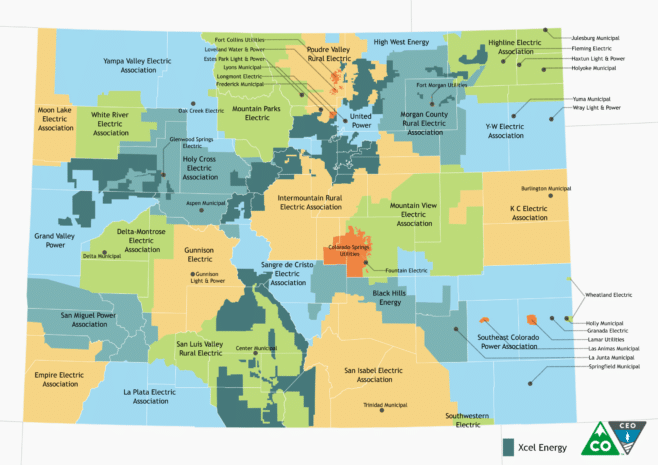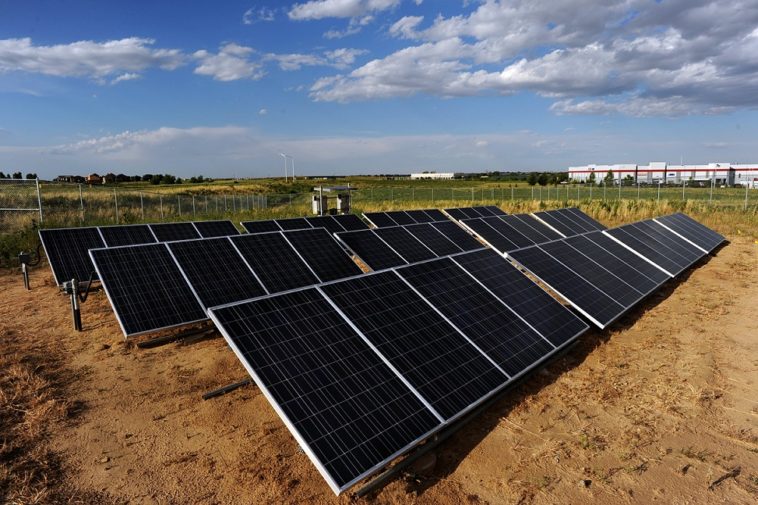The great state of Colorado is joining in on the renewable energy party, or at least will be soon, when Governor Jared Polis (D) signs into law SB19-236, The Colorado Public Utilities Commission sunset bill.
SB19-236, which has successfully passed in the Senate as its accompanying bill did in the House, directs all utilities in the state to a goal of 80% carbon reduction by 2030, followed by 100% carbon-free electricity generation by 2050. Look familiar? It should, because this policy is directly reflective of Xcel’s announcement that it would move to 100% carbon-free electricity by 2050.
What’s funny about this law being the child of corporate policy is the balance of utilities in Colorado. As you could have surmised, since this policy was taken from Xcel, the company must hold some sway in Colorado, which is true, but a bit complicated. Let’s refer to our handy map of Colorado utility distribution, also available here.

See those areas in dark blue? Those are Xcel’s service areas and, while they don’t cover vast expanses of land, they do cover one important area: Denver. What this means in reality is that 2.9 of the state’s 5.7 million people were already under this mandate before the passing of SB19-236.
What’s more is that transitioning to renewables is not a new prospect to the rest of the state, as Platte River Power has a plan in place to go 100% renewable by 2030, with Grand Valley Power following with a 60% clean energy by 2030 goal. On the legislative level, nine cities in Colorado have some sort of plan in place to become 100% powered by renewables, with Fort Collins being the most recent to make such action.
So what does this mean for the adoption and expansion of renewables in that state? SB19-236 includes provisions allowing electric utilities to use low-cost bonds to help refinance retiring fossil fuel generating facilities, a call for distribution system planning and plans to create new workforce and community transition opportunities.
What’s most interesting of those provisions is the prospect of a greater focus on distributed resources. It is stated that the paramount mission of the distribution grid is “to provide the safe, reliable, and resilient service Coloradans depend on.” Because of those key words, reliable and resilient, the commission will now be evaluating how rooftop solar, batteries, and energy efficiency can be utilized instead of traditional “pole-and-wire” distribution. With any luck, this will lead to greater adoption of residential solar + storage in the state.
Outside of distributed energy, further utility scale renewable development is not out of the question either, in fact if other utilities follow Xcel’s lead, it should be expected. This lead being referenced is the company’s plan to build and procure 525 MW-AC of solar, 225 MW of batteries and 1.1 GW of wind, and in the process bring Colorado to 55% renewables by 2026.
What’s for sure is that carbon neutrality and renewable deployment have a symbiotic relationship. Hopefully this relationship has found a new home in Colorado.
This content is protected by copyright and may not be reused. If you want to cooperate with us and would like to reuse some of our content, please contact: editors@pv-magazine.com.









By submitting this form you agree to pv magazine using your data for the purposes of publishing your comment.
Your personal data will only be disclosed or otherwise transmitted to third parties for the purposes of spam filtering or if this is necessary for technical maintenance of the website. Any other transfer to third parties will not take place unless this is justified on the basis of applicable data protection regulations or if pv magazine is legally obliged to do so.
You may revoke this consent at any time with effect for the future, in which case your personal data will be deleted immediately. Otherwise, your data will be deleted if pv magazine has processed your request or the purpose of data storage is fulfilled.
Further information on data privacy can be found in our Data Protection Policy.